Assessment 2: Persuasive Essay on Employee Productivity Factors
VerifiedAdded on 2021/05/31
|9
|2829
|208
Essay
AI Summary
This essay examines the complex relationship between employee productivity, happiness, and financial compensation. It argues that employee happiness is a more significant driver of productivity than better pay. The essay draws upon motivational theories such as Maslow's Need Hierarchy and Herzberg's Two-Factor Theory to support its argument. It highlights the importance of factors like recognition, achievement, and a sense of belonging in fostering employee satisfaction and engagement. The essay also references studies that demonstrate a positive correlation between happiness and productivity, while suggesting that better pay alone may not guarantee increased output. Furthermore, the essay discusses the Hawthorne effect and the Expectancy Theory to show how psychological aspects of work and employee perception of reward can impact productivity. In conclusion, the essay emphasizes that happy employees are more likely to be engaged, motivated, and productive, ultimately contributing to organizational success. The essay also provides various supporting references to back up the claims and arguments made in the essay.
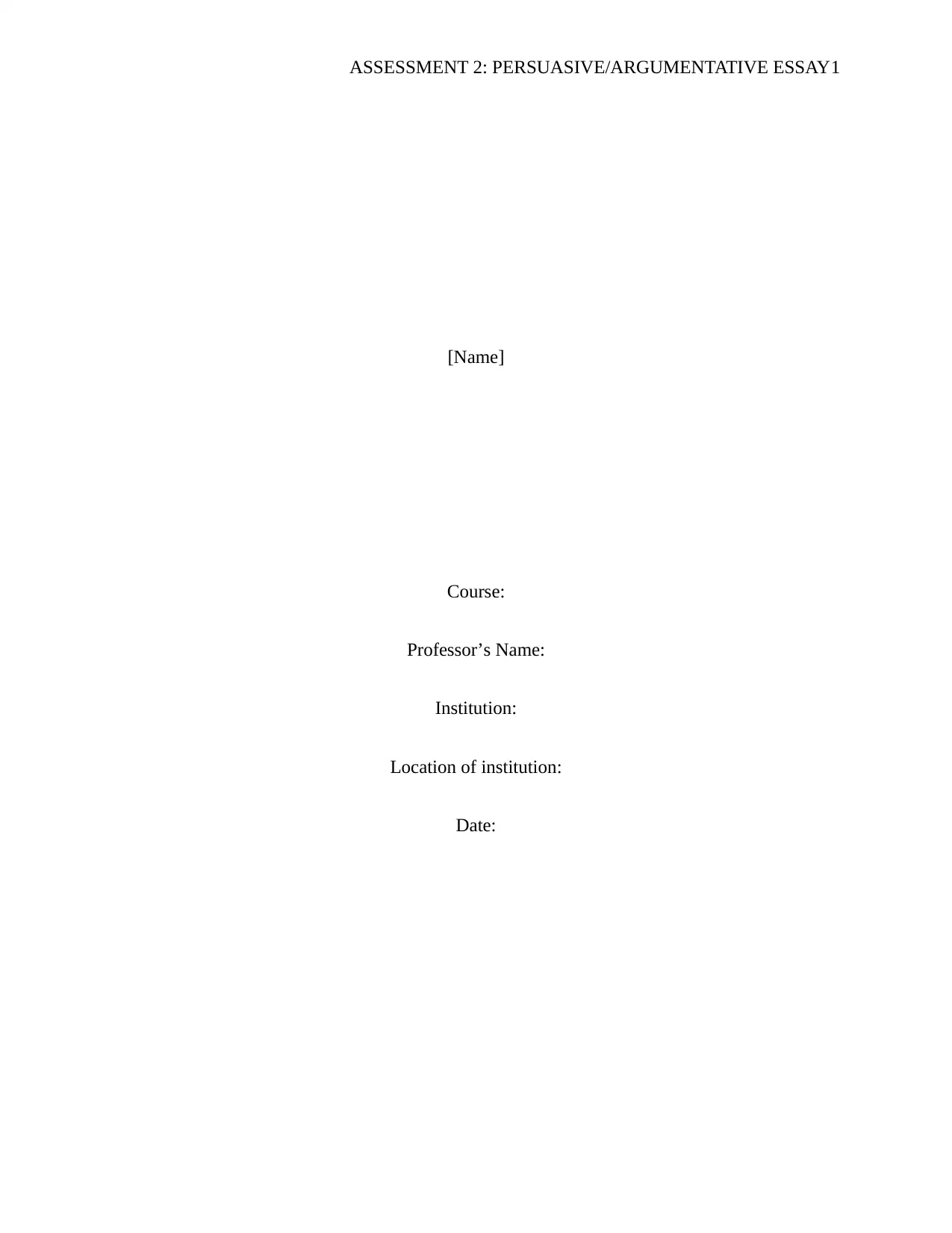
ASSESSMENT 2: PERSUASIVE/ARGUMENTATIVE ESSAY1
[Name]
Course:
Professor’s Name:
Institution:
Location of institution:
Date:
[Name]
Course:
Professor’s Name:
Institution:
Location of institution:
Date:
Paraphrase This Document
Need a fresh take? Get an instant paraphrase of this document with our AI Paraphraser
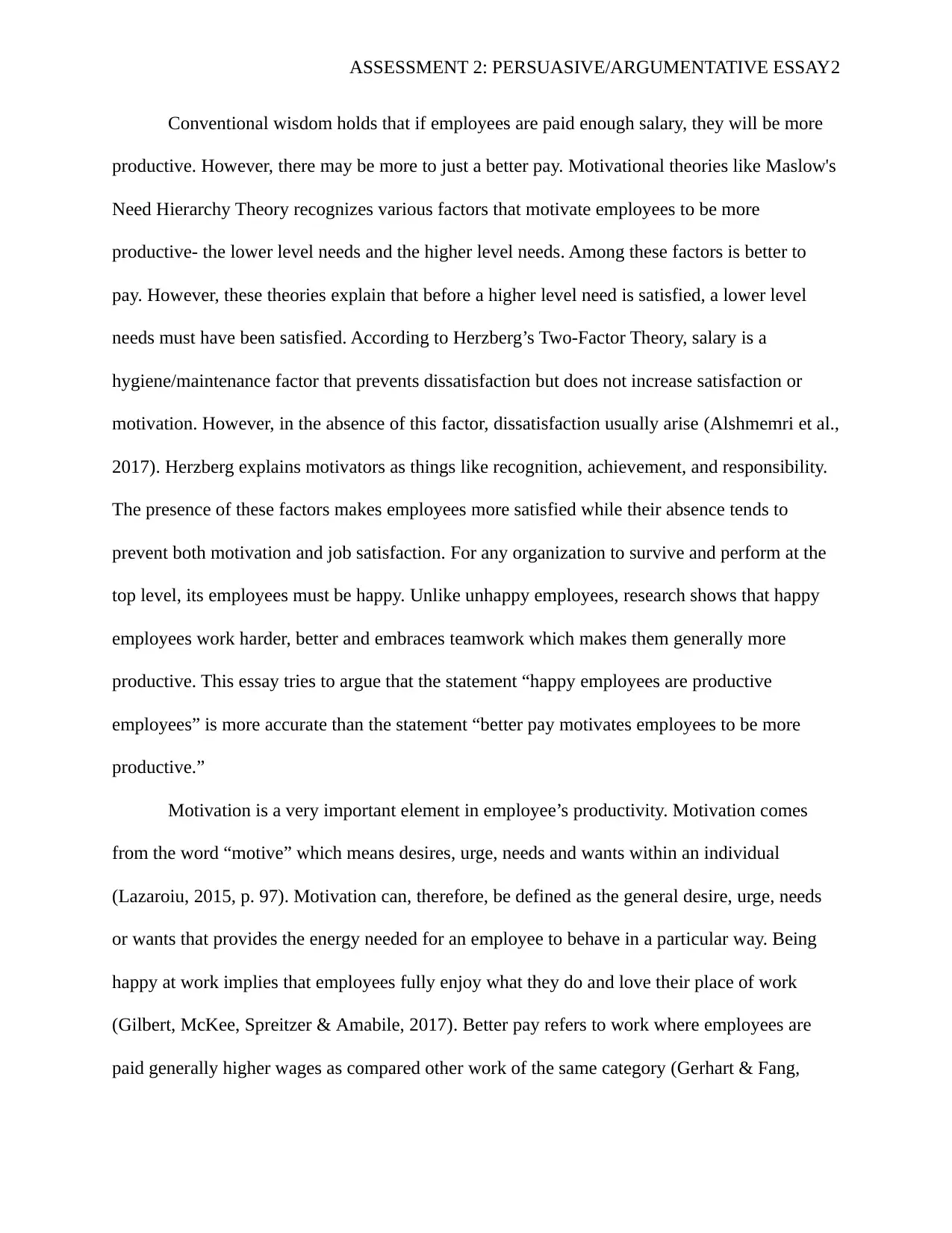
ASSESSMENT 2: PERSUASIVE/ARGUMENTATIVE ESSAY2
Conventional wisdom holds that if employees are paid enough salary, they will be more
productive. However, there may be more to just a better pay. Motivational theories like Maslow's
Need Hierarchy Theory recognizes various factors that motivate employees to be more
productive- the lower level needs and the higher level needs. Among these factors is better to
pay. However, these theories explain that before a higher level need is satisfied, a lower level
needs must have been satisfied. According to Herzberg’s Two-Factor Theory, salary is a
hygiene/maintenance factor that prevents dissatisfaction but does not increase satisfaction or
motivation. However, in the absence of this factor, dissatisfaction usually arise (Alshmemri et al.,
2017). Herzberg explains motivators as things like recognition, achievement, and responsibility.
The presence of these factors makes employees more satisfied while their absence tends to
prevent both motivation and job satisfaction. For any organization to survive and perform at the
top level, its employees must be happy. Unlike unhappy employees, research shows that happy
employees work harder, better and embraces teamwork which makes them generally more
productive. This essay tries to argue that the statement “happy employees are productive
employees” is more accurate than the statement “better pay motivates employees to be more
productive.”
Motivation is a very important element in employee’s productivity. Motivation comes
from the word “motive” which means desires, urge, needs and wants within an individual
(Lazaroiu, 2015, p. 97). Motivation can, therefore, be defined as the general desire, urge, needs
or wants that provides the energy needed for an employee to behave in a particular way. Being
happy at work implies that employees fully enjoy what they do and love their place of work
(Gilbert, McKee, Spreitzer & Amabile, 2017). Better pay refers to work where employees are
paid generally higher wages as compared other work of the same category (Gerhart & Fang,
Conventional wisdom holds that if employees are paid enough salary, they will be more
productive. However, there may be more to just a better pay. Motivational theories like Maslow's
Need Hierarchy Theory recognizes various factors that motivate employees to be more
productive- the lower level needs and the higher level needs. Among these factors is better to
pay. However, these theories explain that before a higher level need is satisfied, a lower level
needs must have been satisfied. According to Herzberg’s Two-Factor Theory, salary is a
hygiene/maintenance factor that prevents dissatisfaction but does not increase satisfaction or
motivation. However, in the absence of this factor, dissatisfaction usually arise (Alshmemri et al.,
2017). Herzberg explains motivators as things like recognition, achievement, and responsibility.
The presence of these factors makes employees more satisfied while their absence tends to
prevent both motivation and job satisfaction. For any organization to survive and perform at the
top level, its employees must be happy. Unlike unhappy employees, research shows that happy
employees work harder, better and embraces teamwork which makes them generally more
productive. This essay tries to argue that the statement “happy employees are productive
employees” is more accurate than the statement “better pay motivates employees to be more
productive.”
Motivation is a very important element in employee’s productivity. Motivation comes
from the word “motive” which means desires, urge, needs and wants within an individual
(Lazaroiu, 2015, p. 97). Motivation can, therefore, be defined as the general desire, urge, needs
or wants that provides the energy needed for an employee to behave in a particular way. Being
happy at work implies that employees fully enjoy what they do and love their place of work
(Gilbert, McKee, Spreitzer & Amabile, 2017). Better pay refers to work where employees are
paid generally higher wages as compared other work of the same category (Gerhart & Fang,
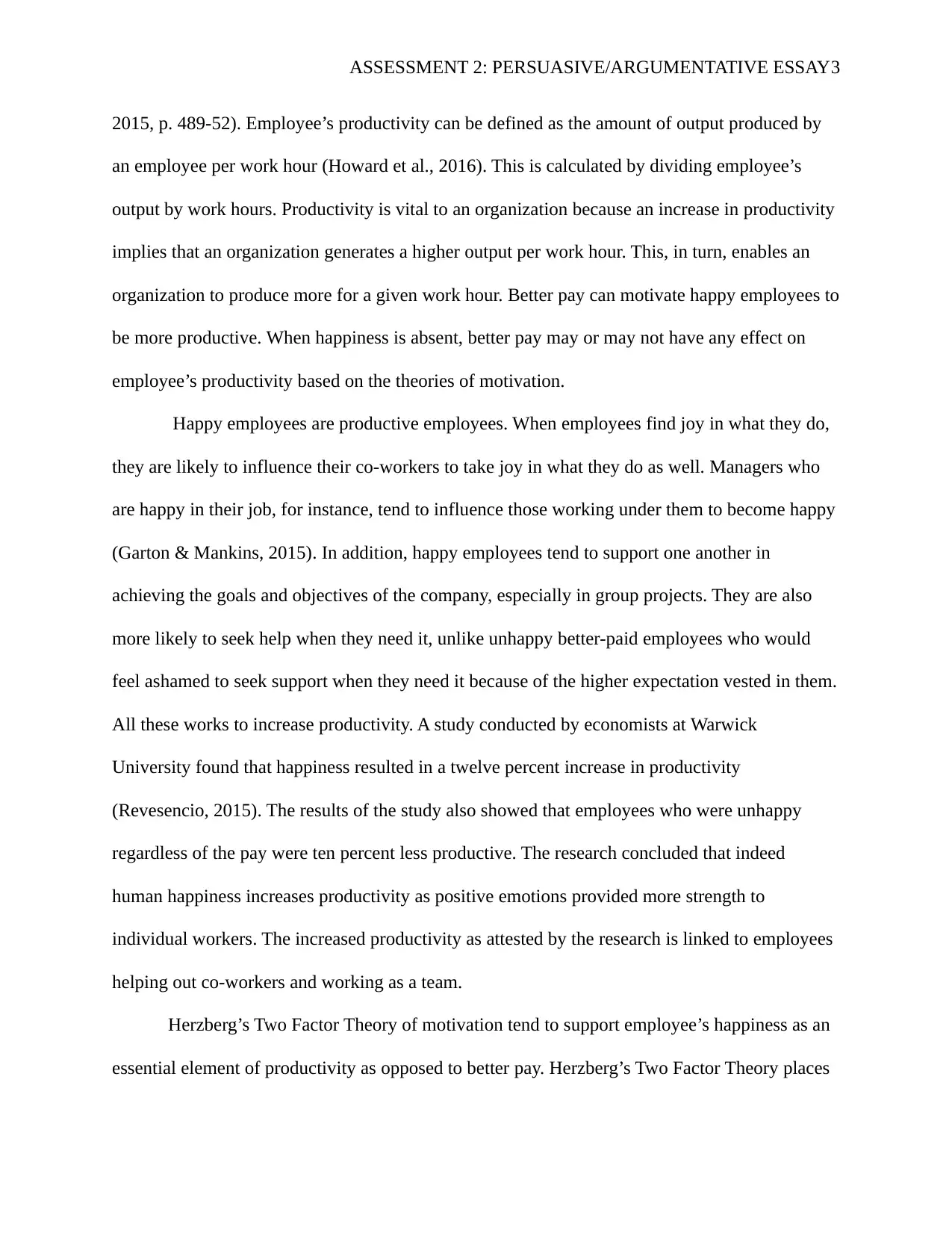
ASSESSMENT 2: PERSUASIVE/ARGUMENTATIVE ESSAY3
2015, p. 489-52). Employee’s productivity can be defined as the amount of output produced by
an employee per work hour (Howard et al., 2016). This is calculated by dividing employee’s
output by work hours. Productivity is vital to an organization because an increase in productivity
implies that an organization generates a higher output per work hour. This, in turn, enables an
organization to produce more for a given work hour. Better pay can motivate happy employees to
be more productive. When happiness is absent, better pay may or may not have any effect on
employee’s productivity based on the theories of motivation.
Happy employees are productive employees. When employees find joy in what they do,
they are likely to influence their co-workers to take joy in what they do as well. Managers who
are happy in their job, for instance, tend to influence those working under them to become happy
(Garton & Mankins, 2015). In addition, happy employees tend to support one another in
achieving the goals and objectives of the company, especially in group projects. They are also
more likely to seek help when they need it, unlike unhappy better-paid employees who would
feel ashamed to seek support when they need it because of the higher expectation vested in them.
All these works to increase productivity. A study conducted by economists at Warwick
University found that happiness resulted in a twelve percent increase in productivity
(Revesencio, 2015). The results of the study also showed that employees who were unhappy
regardless of the pay were ten percent less productive. The research concluded that indeed
human happiness increases productivity as positive emotions provided more strength to
individual workers. The increased productivity as attested by the research is linked to employees
helping out co-workers and working as a team.
Herzberg’s Two Factor Theory of motivation tend to support employee’s happiness as an
essential element of productivity as opposed to better pay. Herzberg’s Two Factor Theory places
2015, p. 489-52). Employee’s productivity can be defined as the amount of output produced by
an employee per work hour (Howard et al., 2016). This is calculated by dividing employee’s
output by work hours. Productivity is vital to an organization because an increase in productivity
implies that an organization generates a higher output per work hour. This, in turn, enables an
organization to produce more for a given work hour. Better pay can motivate happy employees to
be more productive. When happiness is absent, better pay may or may not have any effect on
employee’s productivity based on the theories of motivation.
Happy employees are productive employees. When employees find joy in what they do,
they are likely to influence their co-workers to take joy in what they do as well. Managers who
are happy in their job, for instance, tend to influence those working under them to become happy
(Garton & Mankins, 2015). In addition, happy employees tend to support one another in
achieving the goals and objectives of the company, especially in group projects. They are also
more likely to seek help when they need it, unlike unhappy better-paid employees who would
feel ashamed to seek support when they need it because of the higher expectation vested in them.
All these works to increase productivity. A study conducted by economists at Warwick
University found that happiness resulted in a twelve percent increase in productivity
(Revesencio, 2015). The results of the study also showed that employees who were unhappy
regardless of the pay were ten percent less productive. The research concluded that indeed
human happiness increases productivity as positive emotions provided more strength to
individual workers. The increased productivity as attested by the research is linked to employees
helping out co-workers and working as a team.
Herzberg’s Two Factor Theory of motivation tend to support employee’s happiness as an
essential element of productivity as opposed to better pay. Herzberg’s Two Factor Theory places
⊘ This is a preview!⊘
Do you want full access?
Subscribe today to unlock all pages.

Trusted by 1+ million students worldwide
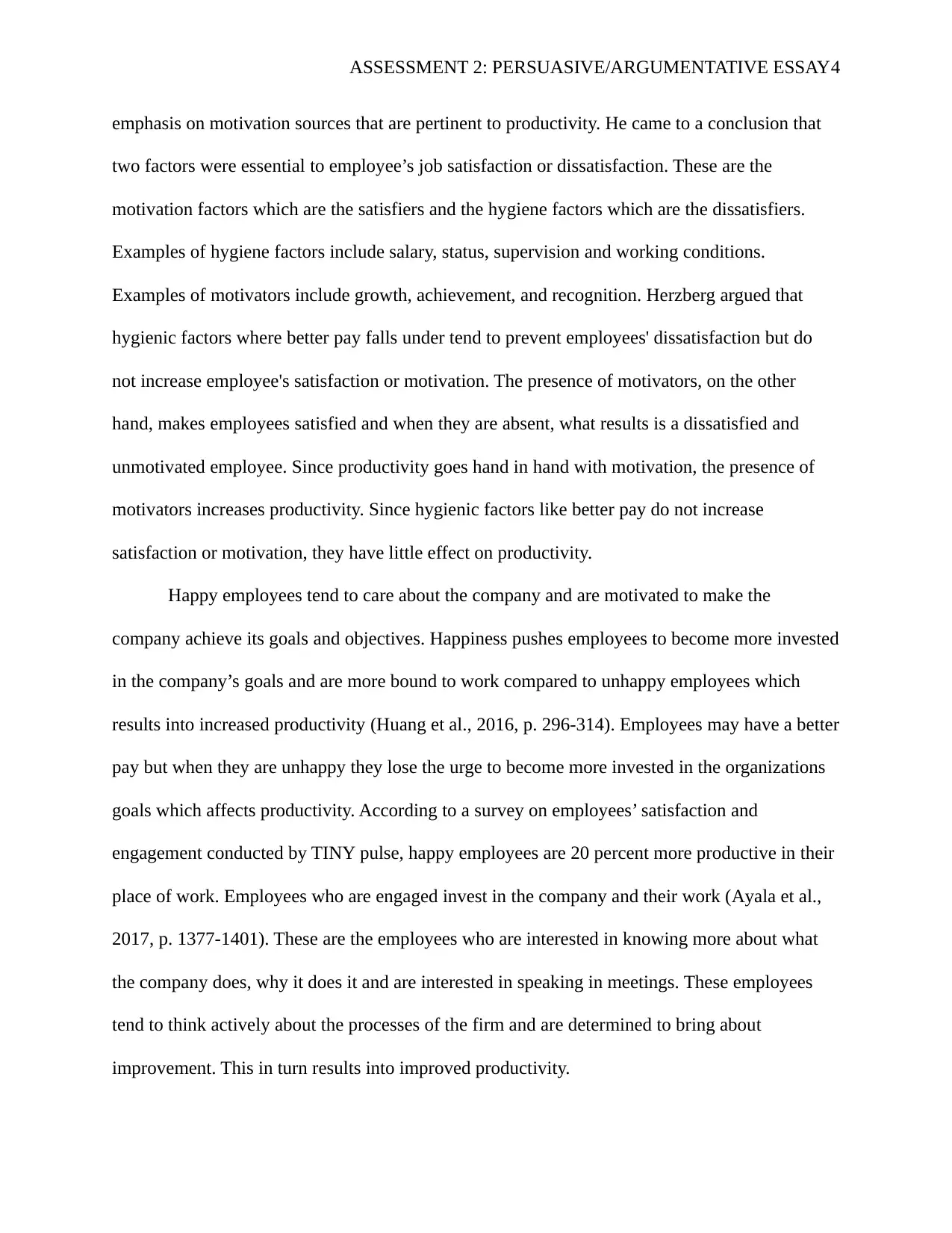
ASSESSMENT 2: PERSUASIVE/ARGUMENTATIVE ESSAY4
emphasis on motivation sources that are pertinent to productivity. He came to a conclusion that
two factors were essential to employee’s job satisfaction or dissatisfaction. These are the
motivation factors which are the satisfiers and the hygiene factors which are the dissatisfiers.
Examples of hygiene factors include salary, status, supervision and working conditions.
Examples of motivators include growth, achievement, and recognition. Herzberg argued that
hygienic factors where better pay falls under tend to prevent employees' dissatisfaction but do
not increase employee's satisfaction or motivation. The presence of motivators, on the other
hand, makes employees satisfied and when they are absent, what results is a dissatisfied and
unmotivated employee. Since productivity goes hand in hand with motivation, the presence of
motivators increases productivity. Since hygienic factors like better pay do not increase
satisfaction or motivation, they have little effect on productivity.
Happy employees tend to care about the company and are motivated to make the
company achieve its goals and objectives. Happiness pushes employees to become more invested
in the company’s goals and are more bound to work compared to unhappy employees which
results into increased productivity (Huang et al., 2016, p. 296-314). Employees may have a better
pay but when they are unhappy they lose the urge to become more invested in the organizations
goals which affects productivity. According to a survey on employees’ satisfaction and
engagement conducted by TINY pulse, happy employees are 20 percent more productive in their
place of work. Employees who are engaged invest in the company and their work (Ayala et al.,
2017, p. 1377-1401). These are the employees who are interested in knowing more about what
the company does, why it does it and are interested in speaking in meetings. These employees
tend to think actively about the processes of the firm and are determined to bring about
improvement. This in turn results into improved productivity.
emphasis on motivation sources that are pertinent to productivity. He came to a conclusion that
two factors were essential to employee’s job satisfaction or dissatisfaction. These are the
motivation factors which are the satisfiers and the hygiene factors which are the dissatisfiers.
Examples of hygiene factors include salary, status, supervision and working conditions.
Examples of motivators include growth, achievement, and recognition. Herzberg argued that
hygienic factors where better pay falls under tend to prevent employees' dissatisfaction but do
not increase employee's satisfaction or motivation. The presence of motivators, on the other
hand, makes employees satisfied and when they are absent, what results is a dissatisfied and
unmotivated employee. Since productivity goes hand in hand with motivation, the presence of
motivators increases productivity. Since hygienic factors like better pay do not increase
satisfaction or motivation, they have little effect on productivity.
Happy employees tend to care about the company and are motivated to make the
company achieve its goals and objectives. Happiness pushes employees to become more invested
in the company’s goals and are more bound to work compared to unhappy employees which
results into increased productivity (Huang et al., 2016, p. 296-314). Employees may have a better
pay but when they are unhappy they lose the urge to become more invested in the organizations
goals which affects productivity. According to a survey on employees’ satisfaction and
engagement conducted by TINY pulse, happy employees are 20 percent more productive in their
place of work. Employees who are engaged invest in the company and their work (Ayala et al.,
2017, p. 1377-1401). These are the employees who are interested in knowing more about what
the company does, why it does it and are interested in speaking in meetings. These employees
tend to think actively about the processes of the firm and are determined to bring about
improvement. This in turn results into improved productivity.
Paraphrase This Document
Need a fresh take? Get an instant paraphrase of this document with our AI Paraphraser
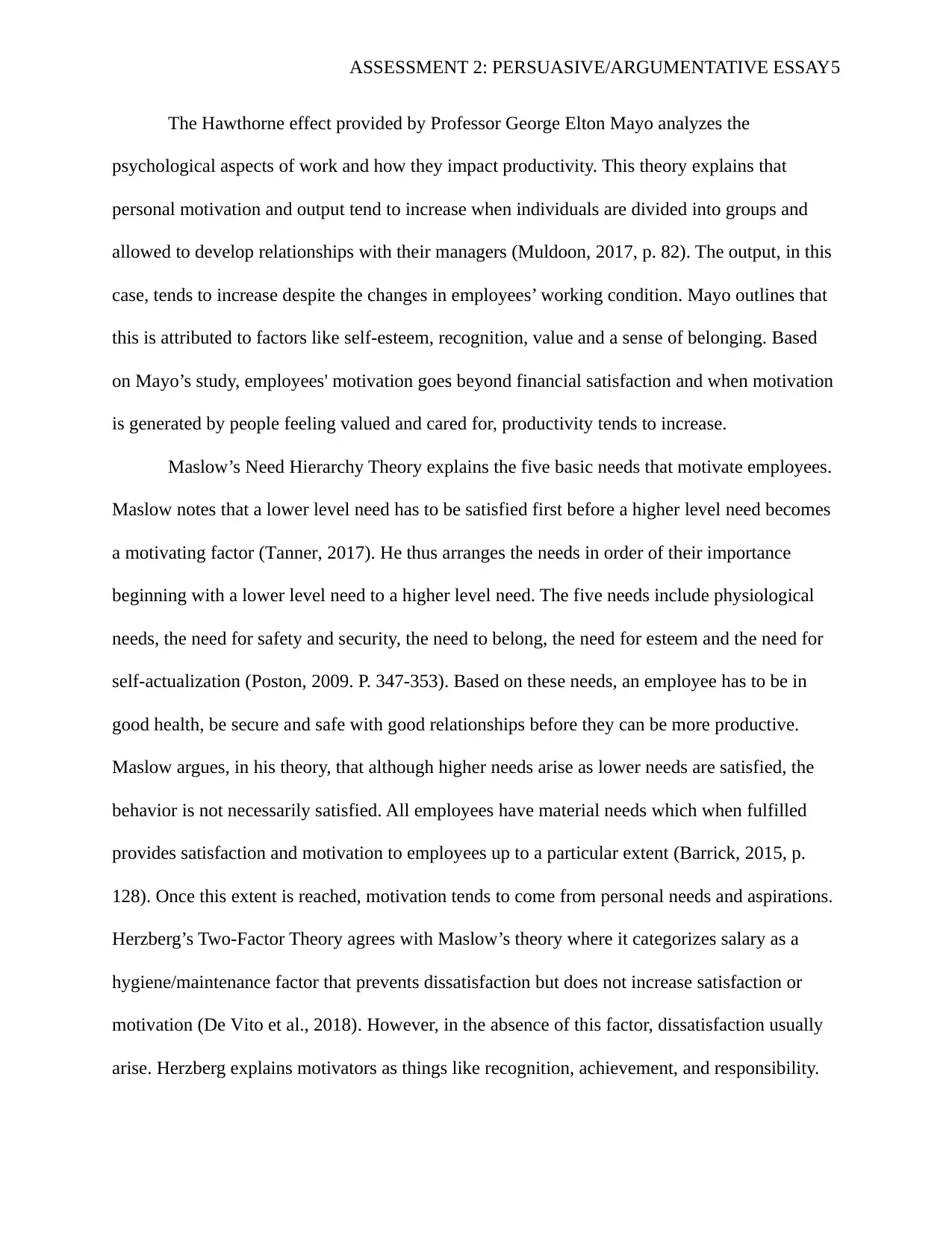
ASSESSMENT 2: PERSUASIVE/ARGUMENTATIVE ESSAY5
The Hawthorne effect provided by Professor George Elton Mayo analyzes the
psychological aspects of work and how they impact productivity. This theory explains that
personal motivation and output tend to increase when individuals are divided into groups and
allowed to develop relationships with their managers (Muldoon, 2017, p. 82). The output, in this
case, tends to increase despite the changes in employees’ working condition. Mayo outlines that
this is attributed to factors like self-esteem, recognition, value and a sense of belonging. Based
on Mayo’s study, employees' motivation goes beyond financial satisfaction and when motivation
is generated by people feeling valued and cared for, productivity tends to increase.
Maslow’s Need Hierarchy Theory explains the five basic needs that motivate employees.
Maslow notes that a lower level need has to be satisfied first before a higher level need becomes
a motivating factor (Tanner, 2017). He thus arranges the needs in order of their importance
beginning with a lower level need to a higher level need. The five needs include physiological
needs, the need for safety and security, the need to belong, the need for esteem and the need for
self-actualization (Poston, 2009. P. 347-353). Based on these needs, an employee has to be in
good health, be secure and safe with good relationships before they can be more productive.
Maslow argues, in his theory, that although higher needs arise as lower needs are satisfied, the
behavior is not necessarily satisfied. All employees have material needs which when fulfilled
provides satisfaction and motivation to employees up to a particular extent (Barrick, 2015, p.
128). Once this extent is reached, motivation tends to come from personal needs and aspirations.
Herzberg’s Two-Factor Theory agrees with Maslow’s theory where it categorizes salary as a
hygiene/maintenance factor that prevents dissatisfaction but does not increase satisfaction or
motivation (De Vito et al., 2018). However, in the absence of this factor, dissatisfaction usually
arise. Herzberg explains motivators as things like recognition, achievement, and responsibility.
The Hawthorne effect provided by Professor George Elton Mayo analyzes the
psychological aspects of work and how they impact productivity. This theory explains that
personal motivation and output tend to increase when individuals are divided into groups and
allowed to develop relationships with their managers (Muldoon, 2017, p. 82). The output, in this
case, tends to increase despite the changes in employees’ working condition. Mayo outlines that
this is attributed to factors like self-esteem, recognition, value and a sense of belonging. Based
on Mayo’s study, employees' motivation goes beyond financial satisfaction and when motivation
is generated by people feeling valued and cared for, productivity tends to increase.
Maslow’s Need Hierarchy Theory explains the five basic needs that motivate employees.
Maslow notes that a lower level need has to be satisfied first before a higher level need becomes
a motivating factor (Tanner, 2017). He thus arranges the needs in order of their importance
beginning with a lower level need to a higher level need. The five needs include physiological
needs, the need for safety and security, the need to belong, the need for esteem and the need for
self-actualization (Poston, 2009. P. 347-353). Based on these needs, an employee has to be in
good health, be secure and safe with good relationships before they can be more productive.
Maslow argues, in his theory, that although higher needs arise as lower needs are satisfied, the
behavior is not necessarily satisfied. All employees have material needs which when fulfilled
provides satisfaction and motivation to employees up to a particular extent (Barrick, 2015, p.
128). Once this extent is reached, motivation tends to come from personal needs and aspirations.
Herzberg’s Two-Factor Theory agrees with Maslow’s theory where it categorizes salary as a
hygiene/maintenance factor that prevents dissatisfaction but does not increase satisfaction or
motivation (De Vito et al., 2018). However, in the absence of this factor, dissatisfaction usually
arise. Herzberg explains motivators as things like recognition, achievement, and responsibility.
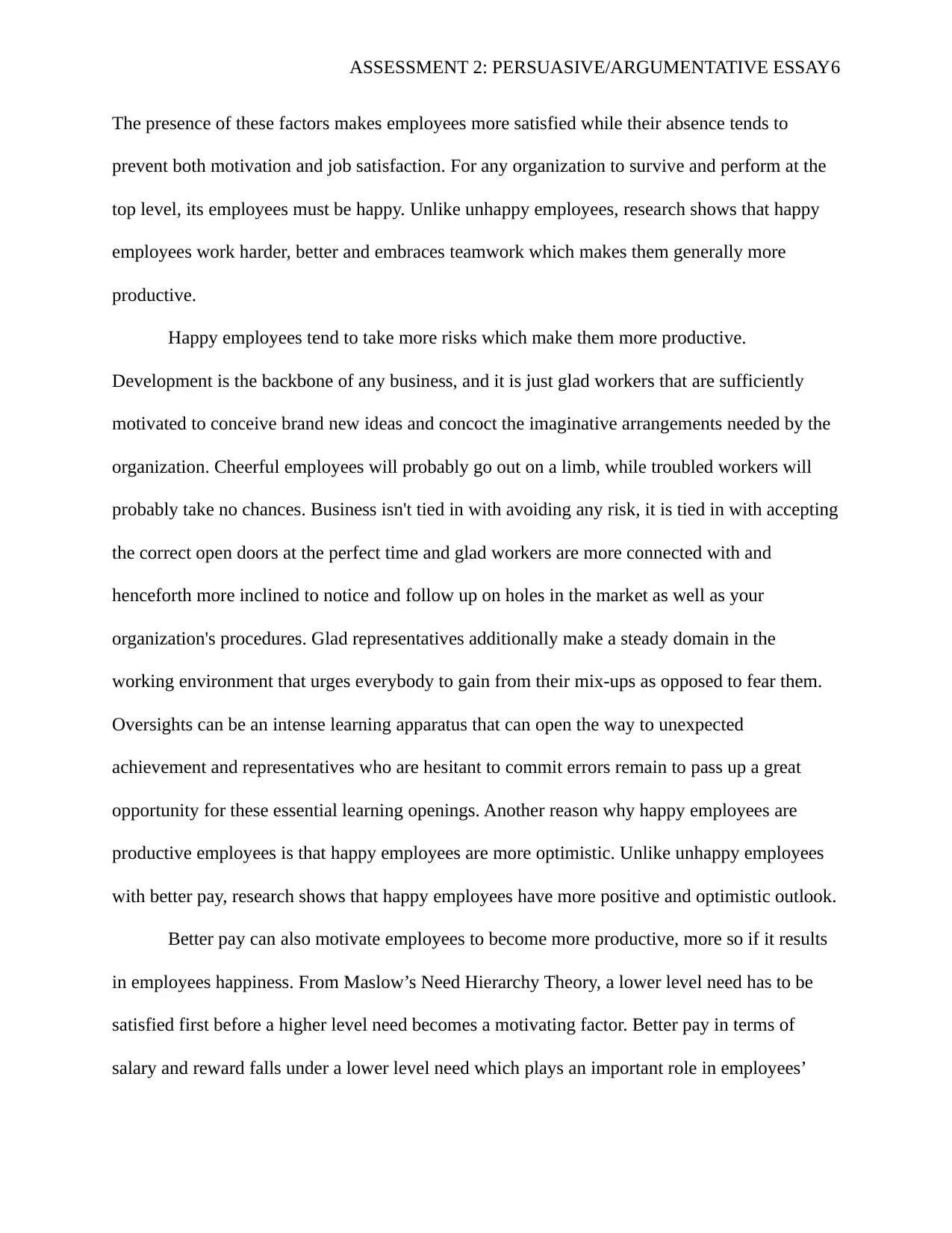
ASSESSMENT 2: PERSUASIVE/ARGUMENTATIVE ESSAY6
The presence of these factors makes employees more satisfied while their absence tends to
prevent both motivation and job satisfaction. For any organization to survive and perform at the
top level, its employees must be happy. Unlike unhappy employees, research shows that happy
employees work harder, better and embraces teamwork which makes them generally more
productive.
Happy employees tend to take more risks which make them more productive.
Development is the backbone of any business, and it is just glad workers that are sufficiently
motivated to conceive brand new ideas and concoct the imaginative arrangements needed by the
organization. Cheerful employees will probably go out on a limb, while troubled workers will
probably take no chances. Business isn't tied in with avoiding any risk, it is tied in with accepting
the correct open doors at the perfect time and glad workers are more connected with and
henceforth more inclined to notice and follow up on holes in the market as well as your
organization's procedures. Glad representatives additionally make a steady domain in the
working environment that urges everybody to gain from their mix-ups as opposed to fear them.
Oversights can be an intense learning apparatus that can open the way to unexpected
achievement and representatives who are hesitant to commit errors remain to pass up a great
opportunity for these essential learning openings. Another reason why happy employees are
productive employees is that happy employees are more optimistic. Unlike unhappy employees
with better pay, research shows that happy employees have more positive and optimistic outlook.
Better pay can also motivate employees to become more productive, more so if it results
in employees happiness. From Maslow’s Need Hierarchy Theory, a lower level need has to be
satisfied first before a higher level need becomes a motivating factor. Better pay in terms of
salary and reward falls under a lower level need which plays an important role in employees’
The presence of these factors makes employees more satisfied while their absence tends to
prevent both motivation and job satisfaction. For any organization to survive and perform at the
top level, its employees must be happy. Unlike unhappy employees, research shows that happy
employees work harder, better and embraces teamwork which makes them generally more
productive.
Happy employees tend to take more risks which make them more productive.
Development is the backbone of any business, and it is just glad workers that are sufficiently
motivated to conceive brand new ideas and concoct the imaginative arrangements needed by the
organization. Cheerful employees will probably go out on a limb, while troubled workers will
probably take no chances. Business isn't tied in with avoiding any risk, it is tied in with accepting
the correct open doors at the perfect time and glad workers are more connected with and
henceforth more inclined to notice and follow up on holes in the market as well as your
organization's procedures. Glad representatives additionally make a steady domain in the
working environment that urges everybody to gain from their mix-ups as opposed to fear them.
Oversights can be an intense learning apparatus that can open the way to unexpected
achievement and representatives who are hesitant to commit errors remain to pass up a great
opportunity for these essential learning openings. Another reason why happy employees are
productive employees is that happy employees are more optimistic. Unlike unhappy employees
with better pay, research shows that happy employees have more positive and optimistic outlook.
Better pay can also motivate employees to become more productive, more so if it results
in employees happiness. From Maslow’s Need Hierarchy Theory, a lower level need has to be
satisfied first before a higher level need becomes a motivating factor. Better pay in terms of
salary and reward falls under a lower level need which plays an important role in employees’
⊘ This is a preview!⊘
Do you want full access?
Subscribe today to unlock all pages.

Trusted by 1+ million students worldwide
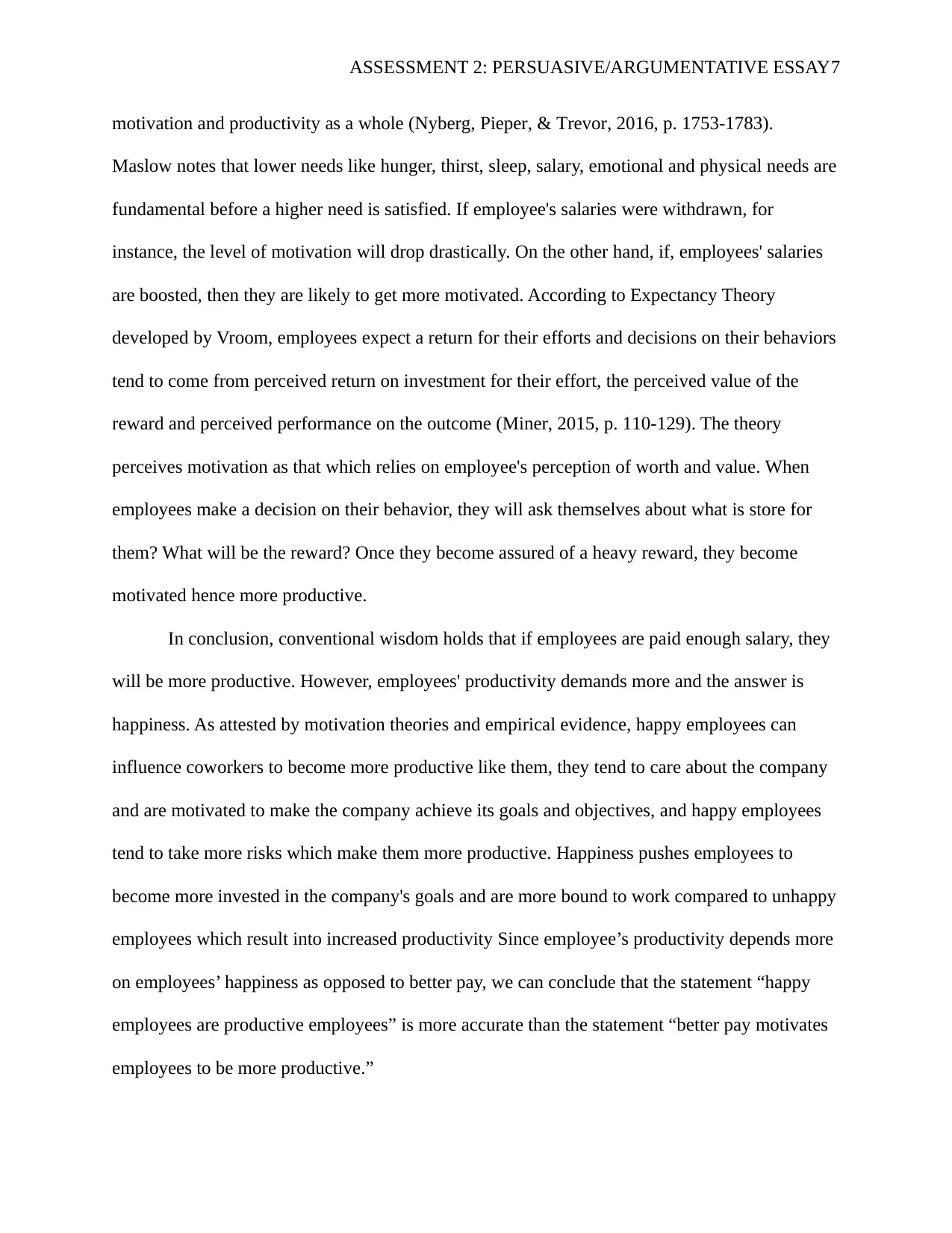
ASSESSMENT 2: PERSUASIVE/ARGUMENTATIVE ESSAY7
motivation and productivity as a whole (Nyberg, Pieper, & Trevor, 2016, p. 1753-1783).
Maslow notes that lower needs like hunger, thirst, sleep, salary, emotional and physical needs are
fundamental before a higher need is satisfied. If employee's salaries were withdrawn, for
instance, the level of motivation will drop drastically. On the other hand, if, employees' salaries
are boosted, then they are likely to get more motivated. According to Expectancy Theory
developed by Vroom, employees expect a return for their efforts and decisions on their behaviors
tend to come from perceived return on investment for their effort, the perceived value of the
reward and perceived performance on the outcome (Miner, 2015, p. 110-129). The theory
perceives motivation as that which relies on employee's perception of worth and value. When
employees make a decision on their behavior, they will ask themselves about what is store for
them? What will be the reward? Once they become assured of a heavy reward, they become
motivated hence more productive.
In conclusion, conventional wisdom holds that if employees are paid enough salary, they
will be more productive. However, employees' productivity demands more and the answer is
happiness. As attested by motivation theories and empirical evidence, happy employees can
influence coworkers to become more productive like them, they tend to care about the company
and are motivated to make the company achieve its goals and objectives, and happy employees
tend to take more risks which make them more productive. Happiness pushes employees to
become more invested in the company's goals and are more bound to work compared to unhappy
employees which result into increased productivity Since employee’s productivity depends more
on employees’ happiness as opposed to better pay, we can conclude that the statement “happy
employees are productive employees” is more accurate than the statement “better pay motivates
employees to be more productive.”
motivation and productivity as a whole (Nyberg, Pieper, & Trevor, 2016, p. 1753-1783).
Maslow notes that lower needs like hunger, thirst, sleep, salary, emotional and physical needs are
fundamental before a higher need is satisfied. If employee's salaries were withdrawn, for
instance, the level of motivation will drop drastically. On the other hand, if, employees' salaries
are boosted, then they are likely to get more motivated. According to Expectancy Theory
developed by Vroom, employees expect a return for their efforts and decisions on their behaviors
tend to come from perceived return on investment for their effort, the perceived value of the
reward and perceived performance on the outcome (Miner, 2015, p. 110-129). The theory
perceives motivation as that which relies on employee's perception of worth and value. When
employees make a decision on their behavior, they will ask themselves about what is store for
them? What will be the reward? Once they become assured of a heavy reward, they become
motivated hence more productive.
In conclusion, conventional wisdom holds that if employees are paid enough salary, they
will be more productive. However, employees' productivity demands more and the answer is
happiness. As attested by motivation theories and empirical evidence, happy employees can
influence coworkers to become more productive like them, they tend to care about the company
and are motivated to make the company achieve its goals and objectives, and happy employees
tend to take more risks which make them more productive. Happiness pushes employees to
become more invested in the company's goals and are more bound to work compared to unhappy
employees which result into increased productivity Since employee’s productivity depends more
on employees’ happiness as opposed to better pay, we can conclude that the statement “happy
employees are productive employees” is more accurate than the statement “better pay motivates
employees to be more productive.”
Paraphrase This Document
Need a fresh take? Get an instant paraphrase of this document with our AI Paraphraser
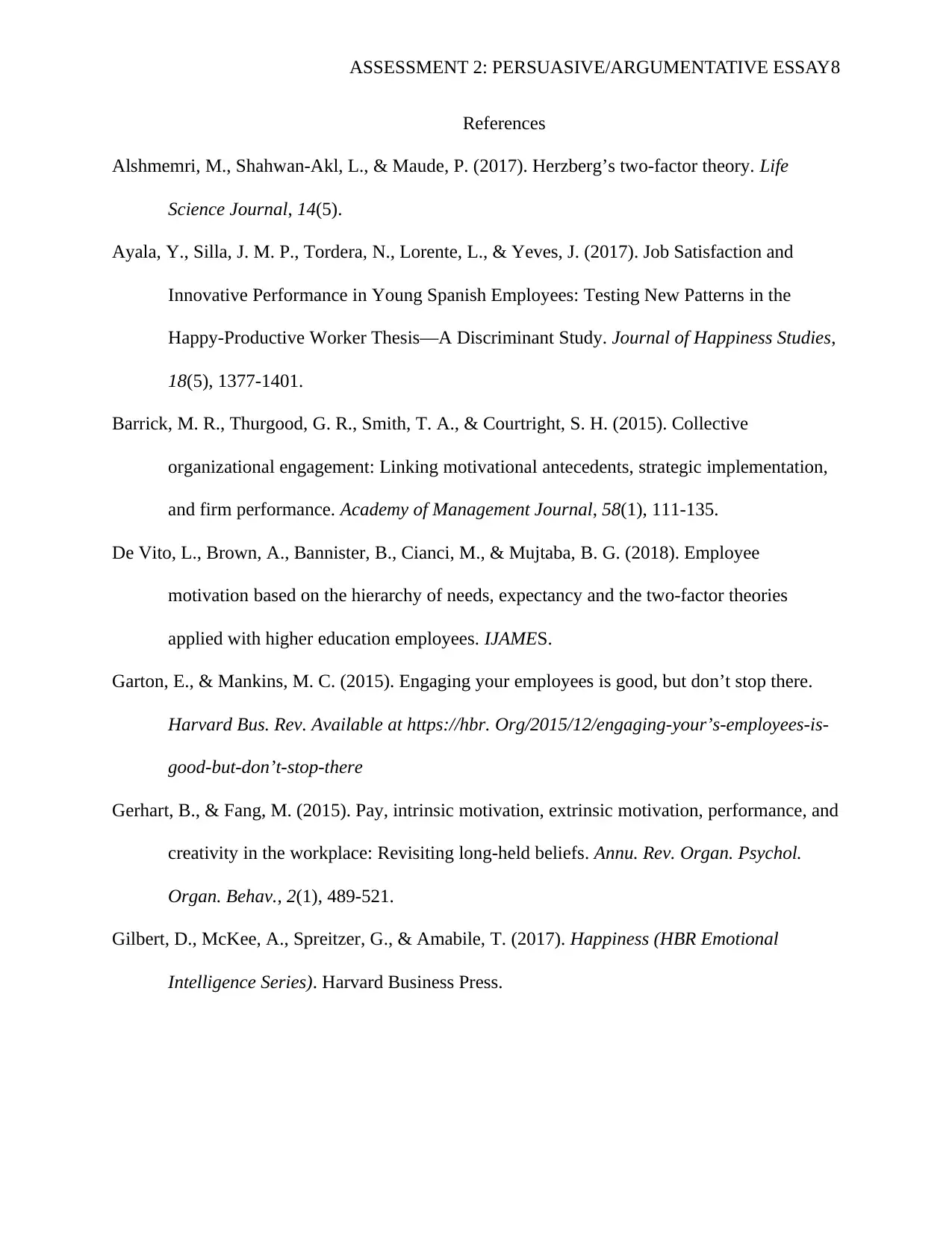
ASSESSMENT 2: PERSUASIVE/ARGUMENTATIVE ESSAY8
References
Alshmemri, M., Shahwan-Akl, L., & Maude, P. (2017). Herzberg’s two-factor theory. Life
Science Journal, 14(5).
Ayala, Y., Silla, J. M. P., Tordera, N., Lorente, L., & Yeves, J. (2017). Job Satisfaction and
Innovative Performance in Young Spanish Employees: Testing New Patterns in the
Happy-Productive Worker Thesis—A Discriminant Study. Journal of Happiness Studies,
18(5), 1377-1401.
Barrick, M. R., Thurgood, G. R., Smith, T. A., & Courtright, S. H. (2015). Collective
organizational engagement: Linking motivational antecedents, strategic implementation,
and firm performance. Academy of Management Journal, 58(1), 111-135.
De Vito, L., Brown, A., Bannister, B., Cianci, M., & Mujtaba, B. G. (2018). Employee
motivation based on the hierarchy of needs, expectancy and the two-factor theories
applied with higher education employees. IJAMES.
Garton, E., & Mankins, M. C. (2015). Engaging your employees is good, but don’t stop there.
Harvard Bus. Rev. Available at https://hbr. Org/2015/12/engaging-your’s-employees-is-
good-but-don’t-stop-there
Gerhart, B., & Fang, M. (2015). Pay, intrinsic motivation, extrinsic motivation, performance, and
creativity in the workplace: Revisiting long-held beliefs. Annu. Rev. Organ. Psychol.
Organ. Behav., 2(1), 489-521.
Gilbert, D., McKee, A., Spreitzer, G., & Amabile, T. (2017). Happiness (HBR Emotional
Intelligence Series). Harvard Business Press.
References
Alshmemri, M., Shahwan-Akl, L., & Maude, P. (2017). Herzberg’s two-factor theory. Life
Science Journal, 14(5).
Ayala, Y., Silla, J. M. P., Tordera, N., Lorente, L., & Yeves, J. (2017). Job Satisfaction and
Innovative Performance in Young Spanish Employees: Testing New Patterns in the
Happy-Productive Worker Thesis—A Discriminant Study. Journal of Happiness Studies,
18(5), 1377-1401.
Barrick, M. R., Thurgood, G. R., Smith, T. A., & Courtright, S. H. (2015). Collective
organizational engagement: Linking motivational antecedents, strategic implementation,
and firm performance. Academy of Management Journal, 58(1), 111-135.
De Vito, L., Brown, A., Bannister, B., Cianci, M., & Mujtaba, B. G. (2018). Employee
motivation based on the hierarchy of needs, expectancy and the two-factor theories
applied with higher education employees. IJAMES.
Garton, E., & Mankins, M. C. (2015). Engaging your employees is good, but don’t stop there.
Harvard Bus. Rev. Available at https://hbr. Org/2015/12/engaging-your’s-employees-is-
good-but-don’t-stop-there
Gerhart, B., & Fang, M. (2015). Pay, intrinsic motivation, extrinsic motivation, performance, and
creativity in the workplace: Revisiting long-held beliefs. Annu. Rev. Organ. Psychol.
Organ. Behav., 2(1), 489-521.
Gilbert, D., McKee, A., Spreitzer, G., & Amabile, T. (2017). Happiness (HBR Emotional
Intelligence Series). Harvard Business Press.
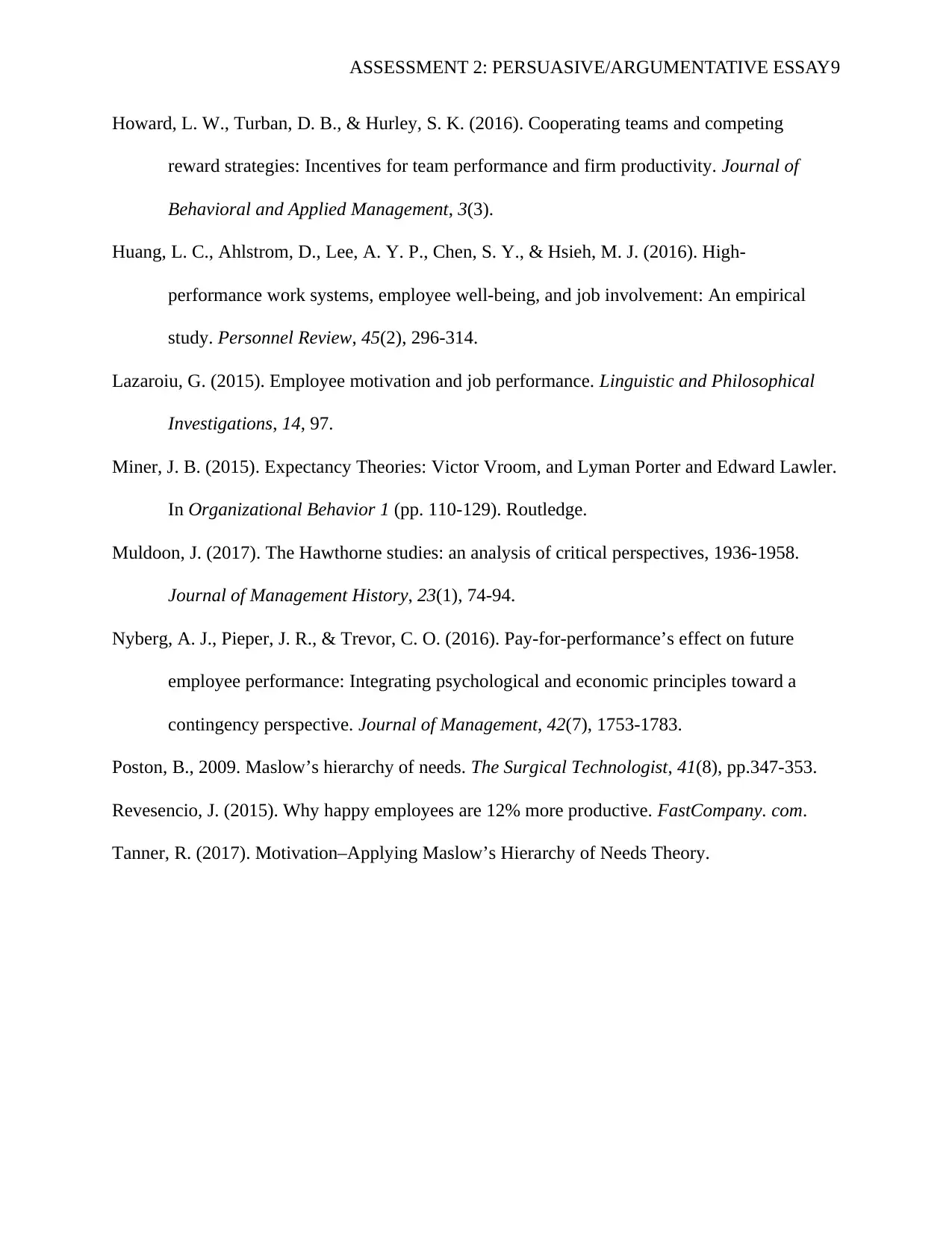
ASSESSMENT 2: PERSUASIVE/ARGUMENTATIVE ESSAY9
Howard, L. W., Turban, D. B., & Hurley, S. K. (2016). Cooperating teams and competing
reward strategies: Incentives for team performance and firm productivity. Journal of
Behavioral and Applied Management, 3(3).
Huang, L. C., Ahlstrom, D., Lee, A. Y. P., Chen, S. Y., & Hsieh, M. J. (2016). High-
performance work systems, employee well-being, and job involvement: An empirical
study. Personnel Review, 45(2), 296-314.
Lazaroiu, G. (2015). Employee motivation and job performance. Linguistic and Philosophical
Investigations, 14, 97.
Miner, J. B. (2015). Expectancy Theories: Victor Vroom, and Lyman Porter and Edward Lawler.
In Organizational Behavior 1 (pp. 110-129). Routledge.
Muldoon, J. (2017). The Hawthorne studies: an analysis of critical perspectives, 1936-1958.
Journal of Management History, 23(1), 74-94.
Nyberg, A. J., Pieper, J. R., & Trevor, C. O. (2016). Pay-for-performance’s effect on future
employee performance: Integrating psychological and economic principles toward a
contingency perspective. Journal of Management, 42(7), 1753-1783.
Poston, B., 2009. Maslow’s hierarchy of needs. The Surgical Technologist, 41(8), pp.347-353.
Revesencio, J. (2015). Why happy employees are 12% more productive. FastCompany. com.
Tanner, R. (2017). Motivation–Applying Maslow’s Hierarchy of Needs Theory.
Howard, L. W., Turban, D. B., & Hurley, S. K. (2016). Cooperating teams and competing
reward strategies: Incentives for team performance and firm productivity. Journal of
Behavioral and Applied Management, 3(3).
Huang, L. C., Ahlstrom, D., Lee, A. Y. P., Chen, S. Y., & Hsieh, M. J. (2016). High-
performance work systems, employee well-being, and job involvement: An empirical
study. Personnel Review, 45(2), 296-314.
Lazaroiu, G. (2015). Employee motivation and job performance. Linguistic and Philosophical
Investigations, 14, 97.
Miner, J. B. (2015). Expectancy Theories: Victor Vroom, and Lyman Porter and Edward Lawler.
In Organizational Behavior 1 (pp. 110-129). Routledge.
Muldoon, J. (2017). The Hawthorne studies: an analysis of critical perspectives, 1936-1958.
Journal of Management History, 23(1), 74-94.
Nyberg, A. J., Pieper, J. R., & Trevor, C. O. (2016). Pay-for-performance’s effect on future
employee performance: Integrating psychological and economic principles toward a
contingency perspective. Journal of Management, 42(7), 1753-1783.
Poston, B., 2009. Maslow’s hierarchy of needs. The Surgical Technologist, 41(8), pp.347-353.
Revesencio, J. (2015). Why happy employees are 12% more productive. FastCompany. com.
Tanner, R. (2017). Motivation–Applying Maslow’s Hierarchy of Needs Theory.
⊘ This is a preview!⊘
Do you want full access?
Subscribe today to unlock all pages.

Trusted by 1+ million students worldwide
1 out of 9
Related Documents
Your All-in-One AI-Powered Toolkit for Academic Success.
+13062052269
info@desklib.com
Available 24*7 on WhatsApp / Email
![[object Object]](/_next/static/media/star-bottom.7253800d.svg)
Unlock your academic potential
Copyright © 2020–2025 A2Z Services. All Rights Reserved. Developed and managed by ZUCOL.





